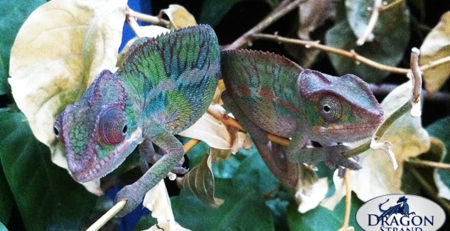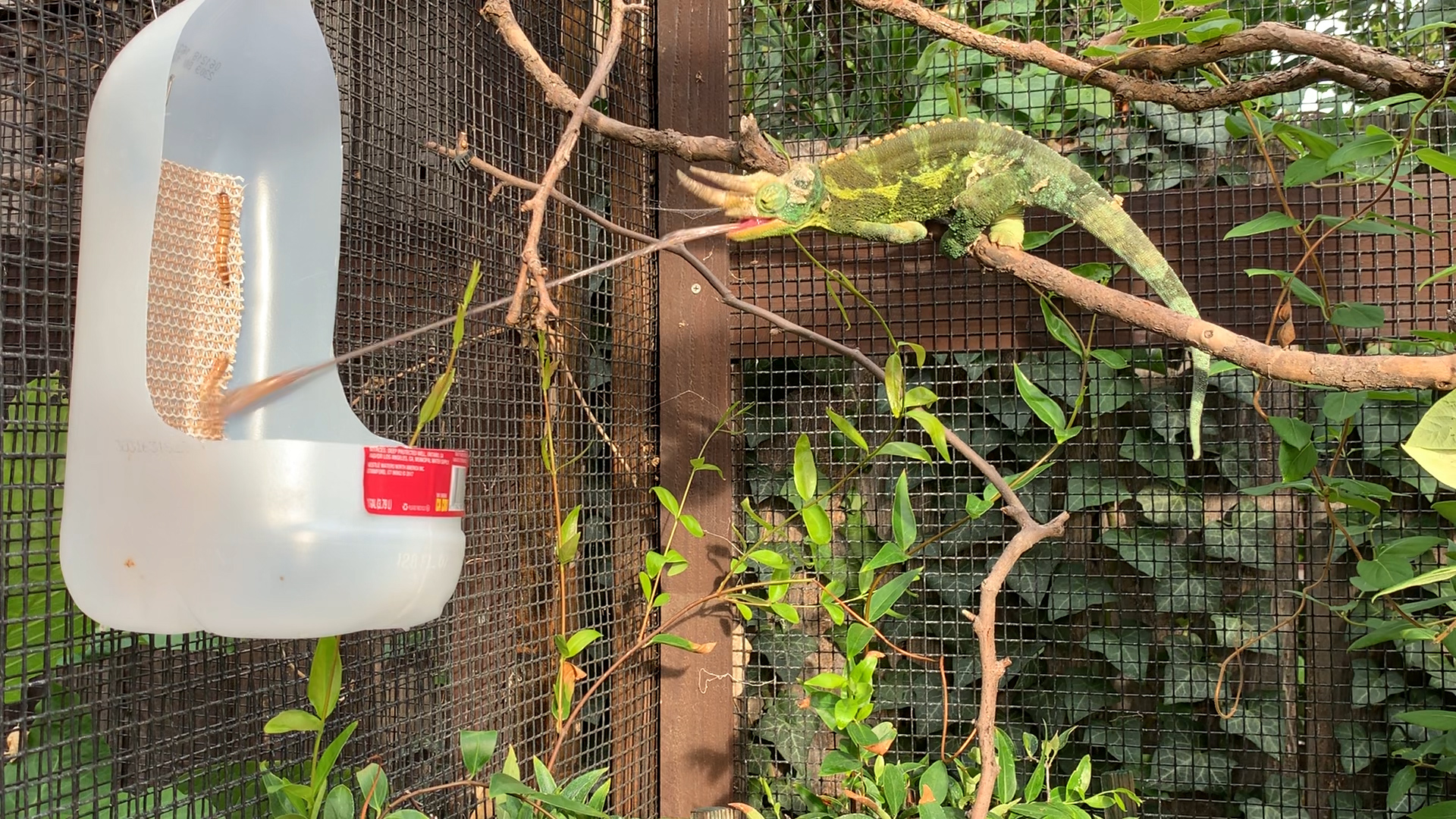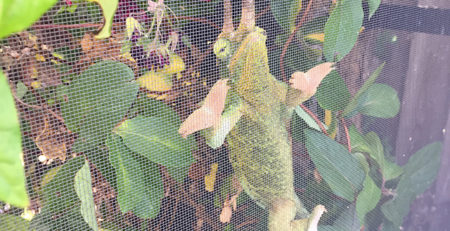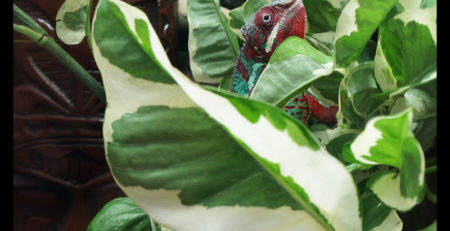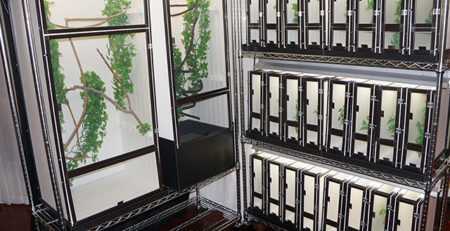Chameleon Cage Setup: Drainage
Chameleon Cage Setup: Drainage
The most complicated part of a chameleon cage setup is the water cycle. Water must be provided in a drinkable form for a chameleon. This requires water dripping or spraying on surfaces and, inevitably, exiting the cage in some manner. When keeping a chameleon indoors, the exit strategy for water is very important!
The easiest drainage strategy for standard cages is to rest the cage on top of a specially made drainage tray. These are simple trays made of PVC made specifically to catch water at the bottom of the cage.

Typical chameleon cages come with either PVC or, sometimes, screen bottoms. If you have a solid floor then water will tend to pool in the center or around the base of whatever potted plants are on the cage floor. A few small holes drilled around the low points (or just at regular intervals around the floor) will take care of the pooling water. I recommend putting in these drainage holes to avoid soaking the poop on the floor. Besides the obvious reason of avoiding a bacterial soup, you want the poop in as much in its original form as possible when you see it. The animal’s waste products are a window into your chameleon’s health.
The size of the holes will depend on the size of the food items that will be in the cage. You do not want them escaping through the drain holes.
Water Drainage and the Health of your Chameleon
Drainage system is more than collecting water waste. It is also a way to measure the health of both your chameleon and your water cycle.
Although independent of the drainage system, it is relevant to the conversation to discuss the poop you see on the floor. Most importantly to this article, it will be an indication of how hydrated your chameleon is. Chameleon poop should be nicely rounded and look moist. Dry poop is an indication that the chameleon is not getting water. If this happens it is time to figure out why – immediately. The reason can be anything from the misting system not working properly to the chameleon not being able or willing to get to the water provided. It is time to get investigating. Evaluate your misting system, drinking surfaces (is the mist reaching them?), or anything else that may be causing the chameleon to not get enough water.
Water Drainage and the Health of your Misting System
It is also a monitor of your water system. There is an illusion with automated watering systems that they save you work. A more accurate assessment is that they change what kind of work you do. An automated system has many different parts that can fail. You must regularly monitor that things are working without getting complacent. The advantage of a misting system is that it works through the day when you are not there. That is the trap, of course. Because you are not there to ensure that it is still working. Any number of things from forgetfulness to failure can, and one day will, go wrong. You do not know when that failure will occur. Here is a non-exhaustive list of very possible failures that could affect common misting systems.
Mister is clogged. The most common use of this is using water with mineral content. But a random material weakness in manufacturing can cause this unexpectedly, as well.
Pump needs to be “burped”. When the top line pumps (Mist King or Aqua Zamp) run dry (turn on when there is no water in the reservoir) they often have trouble getting themselves back to full water moving capacity. To “burp” them, disconnect the outlet tubing from the pump and turn the pump on until water comes out of the output port. Reconnect the outlet tubing and test the system. Always consider that your pump may have run dry if you change out your water once it is too low for the pump to have functioned properly. You could very well have a full reservoir and very little water going to your pets. Note: Economically priced pumps may just overheat and break if run dry. In these cases, this failure point must be changed to “Pump needs to be replaced”.
Power is disrupted. If there is power outage in your neighborhood what you’re your pump timer do? Reset? Does it get shifted so your water cycles happen at night instead of when your pet is awake? Know your how your timer functions.
Timer is left in off position. You may be doing everything right on schedule, but accidentally left the timer in the off position. It happens. Just make sure you have a number of tests you do to catch it. Dehydrated poop is the first sign you’ll see. But your tests should also include how often you refill your water reservoir and how often you need to empty your drainage tray. Any deviation from the normal schedule should be viewed with concern. Find out why you don’t have to fill or empty on your normal day.
Water is dry. The most common failure point is an empty water reservoir. This is especially true if you use opaque containers. For this reason, I like to use transparent containers. Regardless of what container you use, you need a schedule that you follow to check on water level. Running out of water will damage your chameleon’s health. It will also require “burping” your pump as the best case and replacing your pump in the worst case.
So how do we monitor the system? The best way to tell if the water system is working is the level of water in the drainage tray. For water to get into the drainage tray the entire system had to have worked. There is only one fail point that this does not check – A clogged mister that is dripping instead of misting. So you will still need to do periodic checks (every weekend) to visually see if the system is working. But for the daily check, know what level of water you expect in the drainage tray. You will get a feel for how the level changes each day.
Emptying the Drainage Tray
If your water input is balanced by evaporation then you may not need to empty the tray often. Your misting schedule and ambient humidity will decide your emptying frequency for you. You can do something as inexpensive as using a turkey baster to suck water out of the tray for disposal elsewhere. My preferred method is to use a wet/dry vacuum with a slim nozzle and suck all the water out. Home Depot has a reasonably priced unit called the Bucket Head which fits on top of a standard Home Depot bucket. The Bucket Head, Bucket, and crevice nozzle cost me less than $35 and has been worth every cent. If you are interested in this solution order these three parts:
Another option, if you are handy with tools, is attaching a bulkhead to the side of the drainage tray and get a gravity feed to a bucket which is easily carried away for periodic dumping. This method is described in an article by Luis Weidemann who set one up for his Uroplatus Leaf-tailed Geckos. Uroplatus in Dragon Strand Cages. With a larger collection bucket there more time between emptying the drainage tray. If you take it a step further and use a self-priming pump to dispose of the water for you then your drainage is completely automated. I have used this method for years and love it! The one caution I give is the more you automate the further from the chameleon’s care you get. You need to retain that intimacy with more rigorous system testing to detect failure points. Once again I remind you, automation just changes the kind of work you must do to maintain a chameleon. It gives you the freedom for when you perform that maintenance work. But do not let yourself be lulled into complacency because of the freedom that automation allows you.
Conclusion
Though it is a major consideration, drainage is actually very simple. With Drainage Trays specifically made for common cages it should be no problem to implement. Consider how you will accomplish drainage as part of your initial planning. Once you have your water delivery and water removal strategy figured out you are over the major hurdle in your arboreal reptile or chameleon cage setup.
To view the Dragon Strand line of drainage trays that are compatible with Dragon Strand as well as other manufacturer’s cages visit Dragon Strand Drainage Solutions



